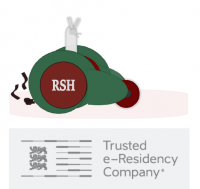How is an Estonian company managed?
Estonian company formation: When you register a company , you’ll receive a private limited liability company (OÜ or osaühing in Estonian) which is registered in Estonia. You will be the sole shareholder and management board member of the company, owning 100% of the shares and having the full control.
An OÜ is the simplest format to run your micro business. According to the law, by default an OÜ is managed by it’s shareholders and management board members.
-
Shareholders have the ultimate decision making power in the company. They are the ones who founded the company in the first place. During the course of business activities they can decide to amend the Articles of Association, increase/reduce share capital, elect/remove members of the management board, approve the annual report and distribute profit, decide on dissolution of the private limited company etc.
-
The management board is the managing body of the company which represents and manages the company, and takes official responsibility for the activities. There is a legal distinction between an official role as a “management board member” and an unofficial role as a “manager”, “director” or similar. The first one comes with the legal rights and obligations valid outside the company as well, but the latter one is for internal or promotional purposes only.
A private limited liability company can also elect a supervisory board, but it’s optional
Since you are both the sole shareholder and management board member of the company, fulfilling both roles at the same time, you are fully in charge and don’t have to bother with the official distinction of decision making rights between the shareholders and the management board members, or the internal reporting requirements. In other words, in case of a single-member company, the corporate governance rules and processes are simplified – a benefit for you. And it’s up to you which title (CEO, manager, director, etc) you use on your business card.
Please keep in mind that the legal power to manage your company comes with equal responsibility. By law, the founders of a private limited company and the members of the management board shall be liable for damage caused to the private limited company by their action or inaction.
Are company’s shareholder(s) names public in Estonia?
Yes, your company’s main information is public, or accessible for a small fee (€1-2), in the Estonian Business Registry. This information is:
-
shareholders’ names
-
shareholders’ date of birth
-
contact email address
-
financial revenue
-
number of employees
-
amount of paid taxes
The requirement originates from the Estonian Commercial Code which states: “Entries in the commercial register are public. Everyone has the right to examine the registry cards and the business files, and to obtain copies of registry cards and of documents in the business files.”
Estonia is very liberal, in the sense of keeping the economic environment transparent and visible, and in promoting open competition. It is important to keep in mind that only a brief financial overview is public, meaning that everyone will be able to see your company’s yearly and quarterly revenues, but they will not be able to see or access any specific transactions, client information or any other specific details about the financials of your company. This also applies to your employees – it is possible to only see the number of employees, not their names or other data.
As your contact email address is public knowledge, you’re likely to receive some undesired spam.
Starting from September 2018, all company owners need to specify in the business registry who is the ‘ultimate beneficial owner’ (UBO) of the company. If you’re a client of LeapIN and have a single shareholder company, you are the ultimate beneficial owner. The purpose of the regulation is to increase the transparency of business operations and avoid potential money laundering.
Do I have to employ myself?
No, it’s not mandatory by Estonian law to employ yourself in your company.
What happens to the company in the case of death?
When creating a company, you are the single owner and management board member of your company. In the event of your death, the company will temporarily have no official board member i.e. nobody can make decisions, sign documents etc on behalf of the company. To solve this, your official heir and/or the most natural person to take over the company would have to submit a written request to the Estonian Court to claim the board member status of the company. It makes sense to use Estonian professional legal advisers to compile the required request and documents. The Court will make a decision in this matter usually within 1-2 months, taking into account the arguments presented. This means the content of the application matters. This way the company’s management can be taken over by your friend as well, even if he/she is not officially your heir, but can prove that he/she is the most logical person for this role.
Once the Court has approved the request, your heir can continue the operations of the company as the board member, access the bank account (assuming he/she has performed the personal KYC with the bank), sign documents on behalf of the company (assuming he/she has applied for e-Residency). And the shares of the company will be transferred as a part of the entire inheritance (assuming there’s more than the shares of the company), again, formalized by the Estonian Court. If nobody from your side makes an effort to become the new board member of the company, the Estonian Court themselves will appoint somebody from their side to act on behalf of the company to clear up the obligations and terminate the company in a decent way.
In what language are the articles of association written?
A template for the articles of association is provided by the Estonian Business Registry both in English and Estonian.
How can I add a new shareholder?
There are two options:
-
Your company issues new shares
That means, while the current share capital of your company is €2 500, the company would increase it by issuing new shares to the new buyer. The payment for the shares would be a contribution to the share capital i.e. not received by you directly. As a result, the new share capital of the company would be €2 500 + €X. While the share capital is measured in nominal terms, the new partner can pay a higher price for the shares as well.If the new shareholder is an individual and an Estonian e-resident as well, this approach can be executed without the need to come to Estonia. The new shareholder would have to pay in the additional share capital for their new shares to the company’s bank account, and digitally sign some documents. The existing shareholder would also need to digitally sign some documents, and make changes in the Estonian Business Register (which can be done remotely).
-
You (existing shareholder) sell x% of existing shares to the new shareholder
This can be executed by using a notary service, but it requires a physical meeting in Estonia with both parties present.As an alternative, existing shares can be sold/bought without a notary if the shares are registered in the Estonian Central Securities Depository, but this requires that both parties have a securities account in Estonia (hosted by an Estonian commercial bank e.g. LHV). Again, this means both parties have to visit Estonia to complete the process at a bank.
As you can see, adding a new shareholder once your company has been established is rather complex.
How can a shareholder leave the company?
Unfortunately, the existing shares cannot simply be cancelled, which means if somebody wants out, he/she has to sell the shares to an existing shareholder or a new shareholder.
If your existing shareholder would like to sell their shares to an existing shareholder
By default it can be executed using an Estonian notary service, but this requires a physical meeting in Estonia with both parties present.
As an alternative, the existing shares can be sold/bought without a notary if the shares are registered in the Estonian Central Securities Depository, but this still requires that all shareholders of the company have a securities account in Estonia (hosted by an Estonian commercial bank e.g. LHV).
If all the shareholders already have access to your company’s LHV bank account i.e. are verified users by LHV, it should be possible to get the securities account remotely, but if somebody doesn’t have access to the LHV account, they’ll need to travel to Estonia to pass the KYC process and get a securities account as well.
It makes sense to confirm the process with LHV before going this way.
If your existing shareholder would like to sell his shares to a new shareholders
The same principles apply. In addition, there’s some more paperwork required (e.g. a statement by existing shareholders that they are OK with the deal etc).
In summary, the legal procedure is rather complex. If you still wish to go ahead, we’d suggest you turn to professional legal advisors in Estonia who can assist you.
We can give some advice, but in case of more complex issues our knowledge can be too limited, because we don’t normally face these questions (in case of single-member entities).
Please let me know if you find any of the options feasible enough for you to get started. Then we can find the best way forward.
Can my business have a branch in another country?
If you establish a branch outside Estonia, your Estonian company would need to register its business operations in this location and would start reporting to the local authorities (in addition to the similar duties in Estonia).
Can my Estonian company be a shareholder of another company?
According to Estonian law, an Estonian company is allowed to be a shareholder of another company, either in Estonia or abroad. There are no limitations assuming the other company is a legitimate legal entity with transparent business activities.
You have some limitations due to the standardised nature of our service. Namely, your company is allowed to:
-
Have a minority (max 30%) share and no controlling rights, in a start-up or any other private company registered in the EU. Please share the related written agreement as a proof of the transaction.
-
Have a minority share in a publicly traded company. Please share the transaction data or grant us a read-only access to your securities account (trading platform).
How can I change my company name?
If you want to change your company’s name, please let your accountant know , and we’ll send you information about the steps you need to complete. The process includes a document (resolution of shareholders) to be completed, signed digitally, and submitted to the business register.
The state fee is €18, and it takes a couple of days to be approved. Before changing the name, please make sure your new name is available. You can check available names with our company name search.
How can I get an Estonian phone number or domain?
Phone number
You can get an Estonian phone number through Twilio, Skype, or Travelsim (who offer Estonian SIM cards at a reasonable price).
Domain
You can purchase .ee domain(s) through Zone.
Postal address
Your company’s postal address is Sepapaja 6, Tallinn 15551, Estonia. All physical mail you receive will be digitized and forwarded to you via email.
All business-related communication costs are considered business expenses and can be covered using your company’s money.
REF :If you wanna be e-residence and opening a company contact to https://www.xolo.io/


